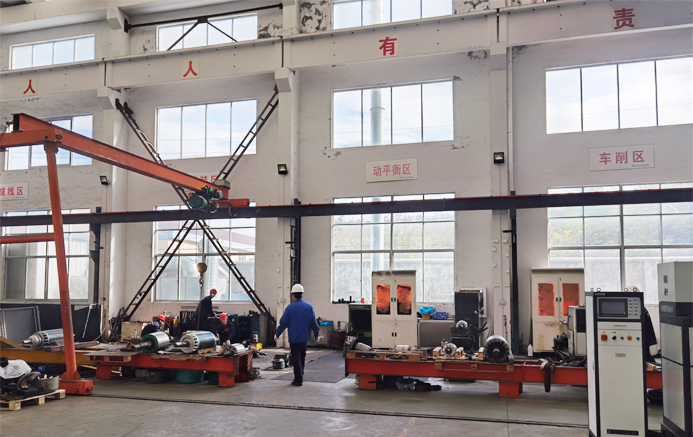When measuring the insulation resistance of the motor winding during motor maintenance, it should be carried out separately in the actual cold state and hot state. During the inspection test, it should be carried out in the actual cold state.
Choose a megohmmeter based on the rated voltage of the motor. When the rated voltage of the motor is below 500V, a 500V megohmmeter should be used, and when the rated voltage of the motor is between 500-3000V, a 1000V megohmmeter should be used. When the rated voltage is above 3000V, use a 2500V megohmmeter. When measuring the insulation resistance of buried or temperature detectors, a megohmmeter not exceeding 250V should be used.
When the starting and ending ends of each phase winding of the motor are led out of the casing, the insulation resistance of each phase winding to the casing and between them should be measured separately during measurement. If the mutual windings are already connected inside the motor and only three outgoing terminals are led out, measure the insulation resistance of all windings to the casing. For wound rotor motors, the insulation resistance of the stator winding and rotor winding should be measured separately. After measurement, the winding should be discharged to ground.
1. Insulation resistance test
Insulation resistance test is the simplest and most basic method to check the insulation status of electrical equipment, and this test is conducted before other tests. By applying a direct current voltage between the winding and the ground, the body resistance and surface resistance of the winding are measured to reflect the defects of the insulation material and structure, as well as the moisture absorption and dirt situation of the insulation. This is a non-destructive test.
Megohmmeters are commonly used on site to measure insulation resistance, with two main specifications: 500V and 1000V. Due to the influence of dielectric absorption current, the indicated value of the megohmmeter gradually increases over time. During detection, the speed is usually at 120r/min, and the value or stable value of 60s after applying voltage is read as the insulation resistance value in engineering. The insulation resistance of the split camera winding should not be less than 10M Ω.
2. DC high-voltage leakage current test
DC leakage current, also known as conductivity current, consists of two parts: one is the current generated along the insulation surface, and the other is the ion current inside the insulation body. In the initial stage of applying DC voltage to the winding, the leakage current also includes the charging and discharging current of the capacitor and the absorption current. The charging and discharging current of the capacitor is generated by the shape, geometric size, and properties of the insulator, and the charging and discharging current of the capacitor is formed under the alternating electric field. The absorption current is the current generated by the repeated polarization of the medium under the alternating electric field.
The purpose of DC leakage current testing is to effectively analyze the results of the leakage current test and identify insulation issues. According to on-site tests, the following conclusion can be drawn: when the leakage current oscillates violently, there are fracture defects in the insulation, which mostly occur in the groove or near the ground at the end. In addition, it is also possible that the wax tube of the outgoing line is damaged. When the leakage current increases over time, it indicates that the insulation has high resistance defects and layering, relaxation, or moisture entering the interior of the insulation. If the leakage current increases disproportionately and exceeds 20% of the adjacent test voltage in the same phase, the insulation will become damp or dirty.
The rapid increase of leakage current at a certain voltage value (i.e. an increase in electronic activity) indicates severe insulation damage and a risk of breakdown. The difference in leakage current between each phase is too large, and the defective part may be far away from the end, or there may be dirt.

3. AC withstand voltage test
AC withstand voltage test, also known as insulation strength test and dielectric strength test, is the most direct method for identifying the insulation strength of electrical equipment and the best simulation of the insulation of AC motors during normal operation. It has decisive significance for determining whether the motor can operate normally, and is also an important means to ensure the insulation level of the motor and avoid insulation faults. It can simulate the actual operation of the motor more realistically than the DC withstand voltage test, and assess the insulation material's ability to withstand high-voltage alternating electric fields.
From the breakdown principle, it can be seen that insulation materials undergo some physical and chemical changes internally in a high-voltage alternating electric field, which can effectively detect local free defects and weak points of insulation aging. Due to the fact that the voltage is mainly divided by capacitance under AC voltage, it can effectively expose insulation defects in the generator slot and defects at the slot, which is a destructive test. Each test will cause damage to the insulation and accumulate. Some hidden dangers and weaknesses inside the insulation material can be exposed during the AC withstand voltage test. Therefore, during the AC withstand voltage test, the voltage of each test should be reduced to 70% -80% of the previous test voltage. During the insulation test of AC motors, the AC test can only be carried out after the insulation resistance test, DC withstand voltage test, and DC leakage current test are qualified. On site, the motor is required to withstand a 2000V power frequency AC withstand voltage test for 1 minute without flashover or breakdown. Motor maintenance

Contact person: Wang Yun
mobile phone:15806202008
phone:0512-62752166
Fax:0512-62753166
Email:yun.wang@ruisiman.com.cn
Website:www.ruisiman.com.cn
Address: 9th Floor, Zhongqi Zero Building, Aigehao Road, Xiangcheng District, Suzhou City